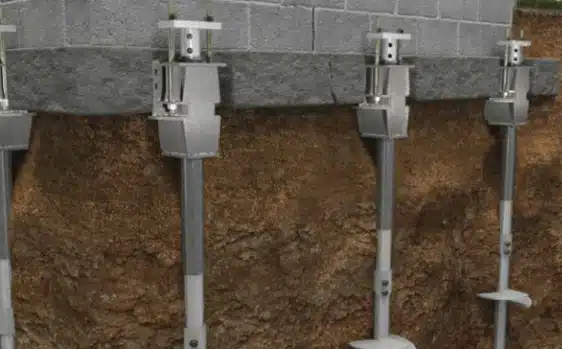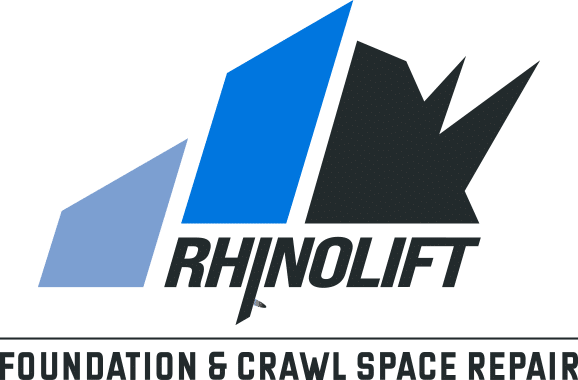Helical Piers
What Is A Helical Pier?
Helical piers are a type of foundation repair solution that consists of steel shafts with helical plates attached to them. The helical plates act like screws that dig into the ground and anchor the piers to a stable soil layer. The piers are then connected to the foundation with brackets and bolts, creating a strong and durable support system.
Helical piers are also known as helical piles, screw piles, or torque anchors. They have been used for over 150 years for various applications, such as bridges, lighthouses, railroads, and pipelines. Today, they are widely used for residential and commercial foundation repair, as well as for new construction projects.
Helical piers can be used to lift, level, and stabilize foundations that have settled or shifted due to soil movement, erosion, or other factors. They can also be used to increase the load-bearing capacity of foundations that are under stress from additional weight or structural changes.

Why Helical Piers Might Be the Right Choice
Our team will help you make the best choice for your foundation repair project. We may choose helical piers depending on the accessibility or scope of the project. Learn more about what makes helical piers the right choice for your project:
Minimal Distruption & Maximum Support
Speed &
Efficiency
Versatile
Applications
What Types Of Foundation Projects Are Best For Helical Piers
Helical Piers are a versatile solution that suits a wide array of foundation projects, including:
Stabilizing Structures
Helical Piers can provide stabilization and prevent further cracking or sinking of buildings showcasing signs of foundation failure.
New Construction
Implementing helical piers in new build projects, particularly where the soil condition may be questionable, ensures a robust foundation from the outset.
Lightweight Structures
Helical piers are great for lightweight work like stabilizing porches, patios, and leaning chimneys.
Additions & Extensions
When expanding your home or commercial space, helical piers can provide additional support to accommodate the added weight and structure safely and securely.
Helical Pier Installation Process
If you have decided to use helical piers for your foundation repair project, you may be wondering how the installation process works. The installation of helical piers requires professional contractors who have the proper training, equipment, and experience to handle the job. At RhinoLift Foundation Repair, we have a team of qualified and certified installers who can install helical piers safely and efficiently. We will explain the steps involved in installing helical piers and what you can expect from the process. Here is how we do it:
Step 1: Site Preparation
Before we start the installation, we will prepare the site by marking the locations of the piers and clearing any obstacles or debris that may interfere with the installation. We will also make sure that there are no underground utilities or pipes that may be damaged by the installation.
Step 2: Pier Installation
Once the site is ready, we will use a hydraulic machine to drive the helical piers into the ground. The machine has a torque meter that measures the resistance of the soil and determines the depth and angle of the piers. The piers are driven until they reach a stable soil layer that can support the foundation load. The number and spacing of the piers depend on the size and design of the foundation and the soil conditions.
Step 3: Foundation Attachment
After the piers are installed, we will attach them to the foundation with brackets and bolts. The brackets are specially designed to fit the shape and size of the foundation and to transfer the load from the foundation to the piers. The bolts are tightened to secure the connection and to prevent any movement or separation.
Step 4: Foundation Adjustment
Once the piers are attached to the foundation, we will use hydraulic jacks to lift and level the foundation as needed. The jacks are placed on top of the piers and apply pressure to raise or lower the foundation until it is aligned and stabilized. The adjustment process is carefully monitored and controlled to avoid any damage or cracking to the foundation or the structure.
Step 5: Site Restoration
After the foundation is adjusted, we will remove the jacks and any excess material from the site. We will also fill any holes or gaps that may have been created by the installation with soil or concrete. We will then restore the site to its original condition or better, leaving no trace of our work.
Contact Us For Professional Foundation Repair Services In Charlotte and the Surrounding Areas
Whether you’re encountering issues with your current foundation or starting a new construction project, our expert team is here to navigate you through a seamless, efficient, and effective foundation repair or new construction pier installation process.
Contact our RhinoLift Foundation & Crawl Space Repair team by calling 888-758-3735 to schedule an appointment. You can also click the button below to fill out our online contact form for a free foundation inspection.

